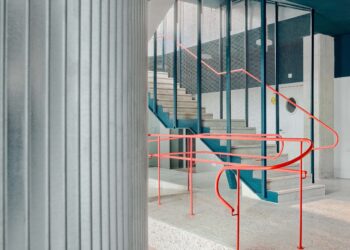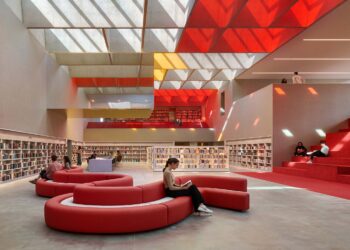Enclosed by concrete walls opens the wilderness

A San Francisco-based family sought our expertise in expanding their existing property located near Lake Tahoe in the Sierra Nevada Mountains. The site is situated on a north-facing slope, offering panoramic views of the Martis Valley below and Lookout Mountain in the distance, all framed by majestic 100-year-old Jeffrey pine trees. In our world today, much of the built work is driven by visual appearance. Symbolic forms and arbitrary material deployment remind us of our history. Usually, these collages of comfort for the eye ignore their contexts that should affect the work in a tangible way. The proliferation of wooden, furniture-like houses in wildland areas at risk of wildfires seems to disregard the inherent dangers of fire, sun, and wind. At CAMPout, comprehensive rigor and consistent deployment of materials based on building-sized decision-making instill a sense of calm and connection for the whole assemblage and ultimately the family.







The material palette is derived from the surrounding context of basalt boulders and sugar pines that cover the forest floor with a mat of rust-colored pine needles. Glazing is strategically limited at the exterior to mitigate fire risk, while the courtyard is designed with generous glazing to allow for safe interaction with the pine forest. Dug into the slope, sleeping areas wrap around a courtyard that earns privacy from neighbors. The family gathering space takes the form of a concrete pavilion that bridges the courtyard to the expansive views beyond. A slender steel shed roof slopes upward, welcoming the southern sun and framing views of the ski runs on the mountain. Built with double 8” concrete walls fitted with foam insulation between extends up to the roof on the low side. Clerestory windows enclose the triangular space between the roof and concrete walls, filling the interior with natural light.
The materiality of concrete and steel sash tempered windows form a fire-resistive barrier and secure a native cedar interior that is left unfinished. The interior is finished with native cedar, left in its natural state to celebrate its organic beauty. Basalt floors are chosen to reinforce the connection with the surrounding landscape, echoing the basalt boulders found in the area. Blackened steel casework complements the exposed steel structure, creating a cohesive design language throughout. A glazed access around the court connects the sleeping rooms and main pavilion to the courtyard and fire much like a campsite. Furnishings share the same materials and tonal qualities further reinforcing a quiet presence that allows the glowing landscape to resonate.







As climate change increases the incidence and magnitude of wildfire events and we continue to reach further into the wild landscape with development, we must enhance the construction systems and materials to withstand these disasters. Early consideration of these factors should be considered along with all other contextual attributes. The form and materials of a building can adopt a protective posture, mitigating the risks of wildfires and promoting safety and sustainability.
Project: CAMPout / Location: Lake Tahoe, California / Architect: Faulkner Architects / Design team: Gregory Faulkner, Christian Carpenter, Jenna Shropshire, Ann Darby / Interior designer: Nicole Hollis / Structural engineer: CFBR Structural Group / Civil engineer: Shaw Engineering / Mechanical, electrical, & plumbing engineer: Sugarpine Engineering / Surveyor engineer: Webb Land Surveying, Inc. / Geotechnical engineer: Nortech Geotechnical Consultants / General contractor: Jim Morrison Construction / Title 24: Monterey Energy Group / Bldg. area: 353m² / Completion: 2022 / Photograph: ©Joe Fletcher (courtesy of the architect); ©Douglas Friedman (courtesy of the architect)




































